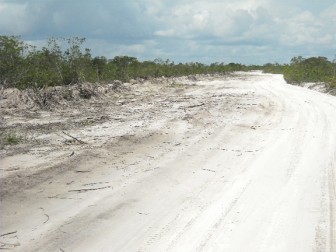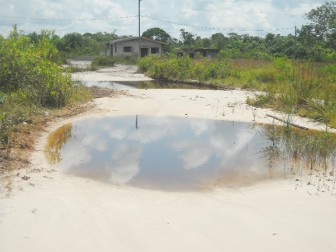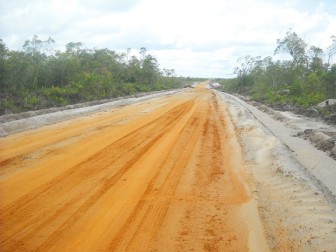The Public Works Ministry has spent $25 million to reconstruct the access road to the St Cuthbert’s Mission and while there has been some improvement, residents of the community are not satisfied with the state of the road.
The $25M utilized to build the road had been committed to the village by President Bharrat Jagdeo during a trip to the Amerindian community last May. The money was to be used to build the approximately 14 mile road from the village to the Linden Highway to make it easier to transport goods to the coast.

Stabroek News recently journeyed to the village and during an interview with this newspaper Village Toshao Ernest Dundas acknowledged the assistance given by the government towards the construction of the road but expressed disappointment at the quality of the work done. “Although it is not in the state that we all expected it to be… at least it has helped since it has been developed to this level,” he said. He said that there was a three-mile stretch of road that is still to be finished but he did not know when this would be completed. There is a huge difference in the quality of the repaired road and the three-mile stretch. The section which has not been completed is rough and has several large potholes, this newspaper observed.
When Stabroek News approached Transport and Hydraulics Minister Robeson Benn recently, he said that the ministry had worked on the road and had improved it significantly. Previously, he noted, only 4×4 vehicles, trucks and other large vehicles could enter the village, but cars and other smaller vehicles could now pass. He said that the money ran out so the full length of road could not be completed, but said that a team will be returning to the community shortly to complete the remaining stretch. Although Benn could not say definitively when the work team would return, he said that the team working on this project was currently engaged in improving the Linden-Ituni road.

Dundas expressed disappointment that the views of the village council were not taken into consideration when the road was being constructed, although the President had said that it was to have a say. “When the President came here and committed $25M towards development of access road from the Linden highway to the village, one of the things he said, was that let the village council along with Ministry of Amerindian Affairs and Works and Hydraulics … coordinate to let the road come to a reality,” Dundas said. After the meeting, he said, the Village Council met with the two ministries and proposed that the villagers build the road themselves. The money, the council proposed, could be used to buy a machine, and the remaining funds could be used to pay an operator and some labourers to work and make the road the way it should be done.
“How we envisioned the road to be done was that it would be built up maybe to about four feet high…and we said maybe we could do that with [sand]” if loam could not be afforded, Dundas said. The intention, he said, was for the Village Council to remain in possession of the equipment to maintain the road, dig trenches and make little roadways in the village. This proposal was rejected by both ministries, and the Ministry of Works and Hydraulics said they would do the road, he explained.
Dundas said shortly after that an engineer and a surveyor came to the village and met with the Village Council. The council had insisted that the road be built to four feet high so that when it rained the water would run off. The Toshao said that when this was completed it would have been easier to place loam or even pitch the road. The engineer, according to Dundas, said they would loam part and build it up, but only to about two feet.
“Now when the work started on the road it was something different… it is not really two feet high. The way how they did the road is that they just moved the top surface of the road where the little pegasse was and then the white sand is there and then they just dig two drains sideways and that’s it,” Dundas said. The village council had asked that they straighten out some points in the road to make it shorter, he continued, but that this did not happen. “In general they did not build it to specify how it should be done,” he said. “So they came in the month of October, they started work on the road and they pulled out from here, I think it is the month of May… to go to other areas to work,” he said; “If they had really worked, and if their machines were in order, that road would have [been] completed before December…They didn’t have to cut down trees or nothing. It was pretty straightforward. It’s just a savannah.”

He said that for the first 3 or 4 miles the work was completed very quickly, then after that things began to fall apart, and they had bad weather.
Questioned about the time it took to complete the road, Benn said that heavy rainfall had impacted on the project. He said that it would not have been possible to construct the road during heavy rainfall.
Asked about the proposal put forward by the village council to build the road, Benn said that had this proposal been agreed to, it was unlikely that this road would have been built since the money would not have been enough to purchase enough machines and material for construction. “We may not have had any road at all,” Benn noted.
Attempts by this newspaper to contact the contractor Lawrence Fiedtkou for an additional comment on the road were unsuccessful.
Other residents, while expressing gratitude for the road’s improvement, said that they still were not satisfied. One resident, Samuel Bernard, in lamenting the state of the road, said that it needed to be improved given the growing population of the village.
Recently APNU presidential candidate David Granger visited the community and had publicized complaints by residents about the state of the road. He had said that $25M had been spent to reconstruct the road, and it was “now a disaster area of sand, mud, grass and water” which only heavy duty and 4-wheel drive vehicles could traverse.




